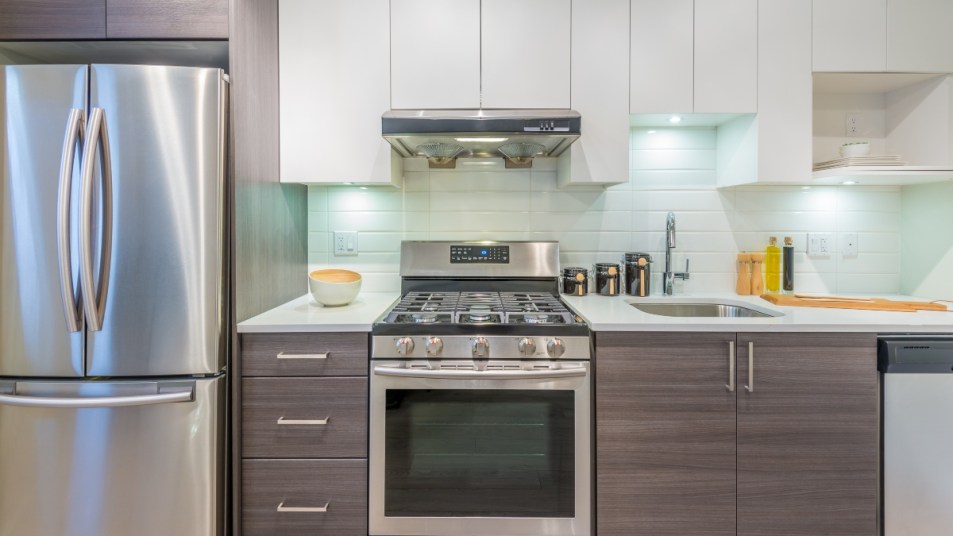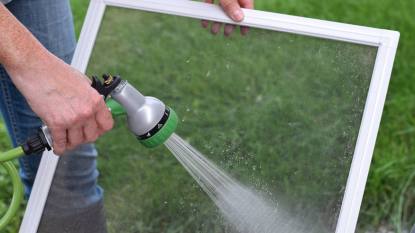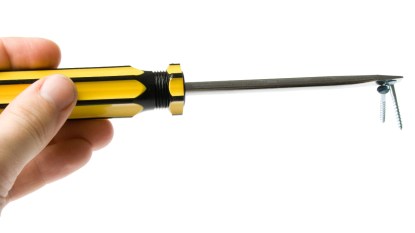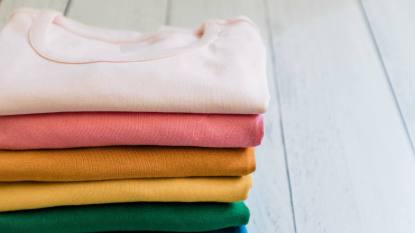How To Clean Stainless Steel Kitchen Appliances and Pots
Despite the name, stainless steel doesn't always stay stain-free.

Stainless steel appliances are modern and high quality, and they give your cooking space a luxurious feeling that other materials just don’t provide. Despite the name, though, stainless steel doesn’t always stay stain-free — it needs just as much care as the rest of your kitchen to sparkle and shine. If you have stainless steel appliances or stainless steel surfaces, you know that fingerprints and smudges are persistent issues. Luckily, there are ways to remove them that are quick, easy, and efficient.
Step One: Assess Your Mess
Cleaning stainless steel appliances isn’t a one-size-fits-all affair. Removing a buildup of water stains on the surface of your dishwasher requires a different approach than removing hard water spots on your stainless steel sink or gunk on your hood or stainless steel refrigerator. The first thing to do is figure out exactly how much cleaning is needed. Are you scrubbing your stovetop or countertop to remove spaghetti sauce residue or an exploded souffle? Is your cleanup going to be as easy as a couple of rinses, or will you need to bring in the Magic Eraser? Before you start cleaning, assess your mess and gather the appropriate cleaning solutions.
Stainless Steel Cleaning Tips for Simple Messes
Some messes can be as simple as a rinse-out with dish soap or a similar cleaning agent. If you’re trying to remove sauce, olive oil, or other grime, try this simple DIY stainless steel cleaner recommended by experts:
- One part water
- One part white vinegar
- A few drops of lemon juice
For this cleaning method, shake up your DIY mixture in a spray bottle and coat the area that needs to be cleaned. Then, use a soft cloth or paper towel to wipe away grime and residue, leaving only a soothing lemon scent behind. (The lemon juice is added largely for its scent, so feel free to get creative with this component. You might swap lemon juice for rose petals or orange zest. Use whatever you want your cleaning product to smell like.)
One trick is to wipe the pan or surface in the direction of the grain. This prevents scratching and scuffing your stainless steel finish. If you aren’t sure of the direction of the grain, try wiping both vertically and horizontally. One of them will put up more resistance; wipe in the direction of least resistance. For finger smudges, sauce residue, spilled cake batter, or olive oil splatters, this water vinegar and wipe combination is sufficient. (Vinegar is actually an incredibly versatile cleaning product.) However, if you’re working with tougher stains, you’ll need a stronger formula.
Level Up Your Cleaning
Some stains won’t come out with a quick warm water rinse and dry cloth wipe down. Perhaps you’ve left the pan out overnight, and its food splatters are crusty and baked on. In this case, you’ll need a stronger method for cleaning your stainless steel. Fortunately, many of the products you already have at home make ideal cleaning solutions.
First things first, though; before you start cleaning, try deglazing the pan (soaking it in hot water). This will loosen up residue, remove simple stains, and generally make the surface easier to clean (without causing any damage to your stainless steel). After deglazing, look to the world’s most effective home cleaning remedy: baking soda and vinegar. For tough, crusted messes, sprinkle the area with baking soda and spray with white vinegar. Alternatively, dampen a microfiber towel with white vinegar and scrub away the baking soda.
Baking soda and vinegar mixtures are a safe, chemical-free way to dissolve tough stains effectively. Another secret weapon that you might already have in your cupboard is club soda. Just like the baking soda and vinegar combination, club soda creates a bubbling action that breaks apart grime and brings your pots and pans back to sparkling.
Rags, Sponges, and More
In terms of your scrubber, you have some options. Start with a microfiber cloth, as it’s your gentlest (and safest) choice. Sometimes, however, you’ll need something with a little more oomph. In that case, use a dish sponge or long-handled dish brush. These are key for removing tough food bits, especially once the surface has been soaked in hot water.
One tool you should avoid when cleaning stainless steel is steel wool. Steel wool might be super effective at getting out tough grime, but it can scratch and damage the finish on your stainless steel. If you want your appliance or pan to have a long lifespan, save the steel wool for ceramics and plastics. Similarly, you should avoid harsh cleaning products like bleach, ammonia, and scouring powders. While these products are great on other materials, you risk damaging the finish of your stainless steel with them. In fact, you should check the manufacturer’s instructions with any stainless steel product or appliance you buy to make sure you don’t use potentially damaging chemicals and cleaning products.
Post-Scrub Maintenance
Whichever method you choose to get your kitchen spick and span, always follow up with gentle dish soap and a second clean microfiber cloth. Vinegar can leave a residue on your stainless steel that may damage it over time. Gently wiping the surface with soap after cleaning will eliminate that residue and prevent long-term damage.
For that same reason, you should buff the surface of your stainless steel with olive oil as well. It might sound counterintuitive, but dropping a little olive oil into a microfiber cloth and gently rubbing it along the stainless steel’s grain can do wonders toward preventing future scuffs and stains. Just be sure not to drench the cloth. (You want your pot or appliance to dry quickly.)
Side note: You don’t have to save this trick for cleaning up a mess. Dot a microfiber cloth with olive oil and gently rub in a circular motion to buff and polish the stainless steel until it sparkles. Doing this semi-regularly will coat your pots, pans, and appliances in a kind of protective shield that reduces minor scuffs and scratches.
Stainless Steel Alternatives
Sparkling stainless steel is nice to look at and great at resisting rust and corrosion. But if all of this upkeep isn’t worth it to you, there are plenty of other great appliance finishes that look just as impressive.
Powder Coating
If you want a high-quality kitchen product in texture or color that’s a bit more fun than steel, powder coating might be for you. It’s spray-on paint alternative that, when properly applied, is durable and high quality.
Matte Metallic Finishes
Many kitchen appliance brands are now offering their products in a matte metallic finish, which is a low-gloss alternative to stainless. This finish is especially great in small spaces, where a ton of stainless steel appliances can over-modernize the space and make it feel like you’re cooking in the Jetson’s kitchen. Metallic matte finishes pair nicely with more colorful and eclectic touches, such as painted cabinets.
Black Stainless
If you want something other than steel gray for your kitchen appliances but don’t want to forfeit the amazing quality of stainless, try black stainless products. Black stainless products are typically coated in a layer of black oxide, which means they have the same durability and anti-corrosive benefits as stainless steel. Because of their dark finish, they tend to be more resistant to fingerprint smudges.
Stainless Steel Like a Pro
Stainless steel is awesome for the kitchen. Not only does it look great, but it also resists rust and corrosion, which means less money spent on replacement pots and pans. Like any high-quality product, though, it requires a little maintenance to keep it in tip-top shape. That extra TLC is a small price to pay, however, for having a beautiful, high-functioning kitchen.













